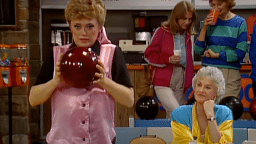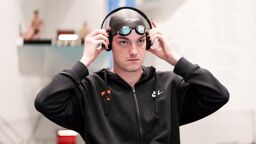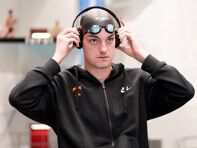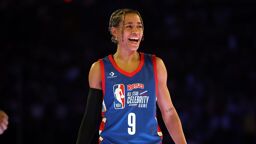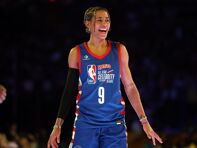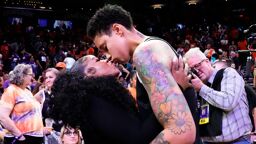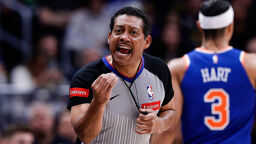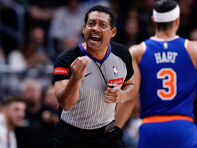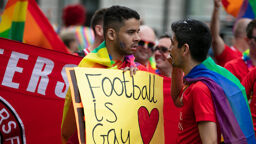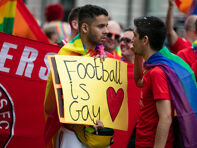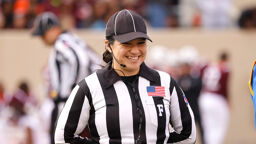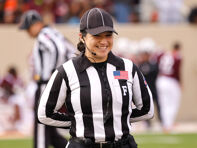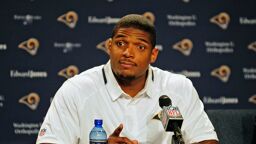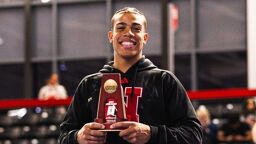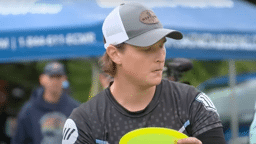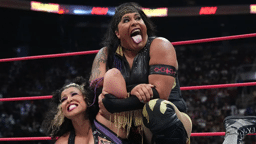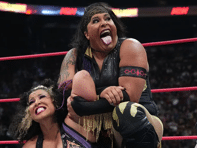(This story was published in 2002).
The issue of gay men’s place in sports has been quietly building for decades, coming closer to the forefront in the last 10 years as Olympians and minor professional athletes come out of the closet. In the early 1970s, female athletes were encountering conflicts of their own: a prejudiced hierarchy of officials and stereotypes that kept them off the field. One woman was there then to help lead the charge for women onto the race courses of America, and offer the first glimmers of hope for gay men quietly opening closet doors in sports.
When Patricia Nell Warren published The Front Runner, a novel about a distance running coach and his lover and star athlete, in 1974, the notion of a top athlete being gay was an inconceivable idea. Former NFL player Dave Kopay had not yet told his story; there were no Olympic gold medallists like Greg Louganis to point to; Billy Bean was in fifth grade.
Nearly 30 years later, having sold 10 million copies in nine different languages, her work still affects gay men and women around the world.
Just as fascinating as the story of The Front Runner, yet one that is virtually untold, is that of the woman behind it: a story in which women simply weren’t allowed to compete in athletics, when “lesbians” were that quiet thing that no one ever talked about; and one woman had the guts to tell a story like none had been told before.
“Young people have no idea that any of this ever happened,”
Warren said.
A Woman Athlete in a Man’s World
Growing up in Montana in the late `40s, Warren had always had an affinity for sports, though her outlets were limited: there was no girls’ track team and, in girls’ softball and basketball, there were limits written into the rules on how much running was allowed.
“If there was a track team, I would have run,” said Warren. She was fast as a child, and would have probably focused on sprints rather than distance running. Twenty years later, away from the farmlands of the West and in New York, Warren decided to break from societal constraints and run a marathon.
“I got started distance running on a dare,” recalls Warren, who now writes out of her home office in Los Angeles. Long-distance racing didn’t really exist before the 1960s, when the jogging craze hit America, followed soon by local road races in every corner of the country. In 1968, then an editor at Reader’s Digest in New York City, Warren and a friend dared each other to train to run a marathon.
Earlier that year, a woman named Kathy Miller (who later became Kathy Switzer) had obtained a number through the mail to run in the Boston Marathon, by registering as simply “K. Miller.” At that time, women were not allowed to run in a marathon, per Amateur Athletic Union sanctions. During the race, the race director saw the woman running with a number and intercepted her on the course. He grabbed at the Miller and ripped the number off of her. Coming up behind Miller was her boyfriend, an Olympic hammer thrower, who punched the race director, took the number back, and left the director flat on his back.
The Boston press picked up the story and finally began to ask the question that women had started asking the AAU: why were women not allowed to run marathons?
Soon after, Warren and her friend started to go on a daily jog after work. They started with simply 100 yards. Then a quarter mile, then a half-mile, and soon they were taking long runs around Central Park. By April of 1969, she and her friend were ready to head off to Boston and quietly sneak into the Marathon.
Once there, Warren’s goal was not only to finish the race but to break four hours. Two-thirds of her way through the race, though, exhaustion and pain began to set in.
“The first 18 miles, no problem,” says Warren. “That last 8.2, just deadly. They used to talk about the man with the hammer coming and hitting you on the head.” In that 19th mile, she felt the hammer come down hard. Near physical exhaustion, she began to consider dropping out of the race.
“They had something called the ‘losers bus,’ which goes along and picks people up who had broken down on the course. The losers bus pulled up beside me, opened the door and the driver said, ‘Come on doll, you’ve had it, get in.’ ”
In that moment, she decided she would finish the race if she had to crawl. After surviving the long stretch down Commonwealth Ave., and rounding the corner for the last leg to the Prudential Center, Warren crossed the finish line in just over 4 hours and 20 minutes..
“That was like the gold medal in the Olympic Games–crossing that finish line, and being the fifth woman ever to do so.”
After that, the Boston Athletic Association, which hosted the race, began inviting women to participate, giving them locker rooms and numbers, in defiance of the AAU. In 1972, women were officially acknowledged by the BAA in the Boston Marathon. Two years later, the most biggest-selling gay-themed novel in history, about a gay coach and his runner, would be released.
The Front Runner Takes Shape
“Along the way, with all the women’s rights stuff, I started meeting other women like myself who were on their way out of the closet,” says Warren. “And I thought to myself, hmmm, this would make a terrific novel.”
She started outlining The Front Runner as a story about a lesbian coach and one of her runners, who became lovers. Very quickly, she began to realize that, in that concept, there were a couple of inherent flaws.
“There were no women coaches when I wrote this book. When I finally looked around at real life I thought, nobody will believe this because there aren’t any women coaches in track.” The story simply wouldn’t have credibility if it involved two women.
“Plus, if you were going to have a cliff-hanger story about being outed on the way to the Olympics, if you were a woman athlete, you’re automatically suspect by many people anyway.” She decided to develop the story about a male couple, instead.
When the book was released in 1974, it began climbing the New York Times best-seller list. Despite her straight colleagues praising her for the work, many in the burgeoning gay community felt betrayed.
“It was controversial with the more politically correct elements in the gay world who felt I had no business writing about men, and they told me so. I had my face spit in a few times by gay men and a few women,” she said. The lesbians felt that she had betrayed her sex and crossed the sex barrier–in their eyes, she had become a sellout.
The impact of the book, however, has been felt ever since. Gay running organizations around the world now call themselves “The Front Runners,” inspired by Warren’s book. Many gay men and women, especially athletes, continue to recount how important The Front Runner was in coming to terms with their own sexuality. Warren continues to receive e-mails from gay runners in high school and college who, born long after the book was written, connected with the story of Harlan and Billy and their fight for survival in the homophobic world of sports.
Gays in Sports Today
Warren can see parallels between the battle she and other women had to fight in the sports world, and the social battle that now faces gay men in college and professional sports. Both involve a few who want to step forward initially and take some heat, and both stem from a few wanting to challenge old, conservative stereotypes.
In talking with openly gay runners on teams around the country, each of them emphasizes the importance of two things. First, the few that step forward have to be likable, and talented, athletes – someone who is unlikable won’t change attitudes. Second, they need the support of some key straight allies. As Warren remembers, it was some of the few straight white male supporters who helped women break through the sex barrier in running.
“Without the support of the men in the sport, it would have been very hard for the women to get anything done. It was the level of support from the men, and finally men coaches, and men race directors gave us the swing vote in the AAU. It’s important to line up your swing vote.”
The Front Runner Movie
In recent years, Warren has set her sights on tackling the homophobia in the entertainment business. She originally sold the film rights of The Front Runner in the late 70s to Frank Perry, after Paul Newman had an option for a year. Perry couldn’t get funding and he sold the rights to Howard Rosenman. Rosenman then sold the rights to another man who eventually died of AIDS. Warren went to court in the early `90s to get the film rights back, and finally won them in 1997.
After five years of searching for funding for The Front Runner movie, Warren and her Wildcat Entertainment business partner, producer Tyler St. Mark, are still looking. Over the years, St. Mark has taken meetings in most of the major studios in Hollywood, with many executives who love the book and love the project.
“But there are safe subjects which show gay people as victims, or bad people, or weak or effeminate,” Warren says. Many have told St. Mark that The Front Runner, diving headfirst into the homophobic arena of sports, is too much of a monetary risk for the major studios.
“There are gay people who are out in Hollywood who won’t touch this film because it’s too much of a risk,” Warren adds. “Tyler has taken meetings with people who tell me that they read it when they were young and they cried on the train while reading it, and then they’ll tell Tyler why they can’t make it.”
Undaunted, Wildcat Entertainment pushes on with the project that has defined so much of Warren’s life. The movie about the story of Harlan and Billy has been 30 years in the making. And, like those last few miles of the marathon, she’s refusing to get on the loser’s bus just yet.
2002
You can find Patricia Nell Warren’s Books at:
Search:
Keywords:
Warren lives in Los Angeles where she co-owns her publishing company, Wildcat Press, and her film-development company, Wildcat Entertainment, with Tyler St. Mark. Since writing The Front Runner, she has written two sequels to the book: Harlan’s Race (1994) and Billy’s Boy (1997). Most recently, she has delved into the arena of bullfighting, with The Wild Man, her story of a disillusioned bullfighter and his growing passion for another man in 1960s Spain.
Telling stories, be they about distance runners, bullfighters or Mayan priestesses, is her passion. She also expresses her creativity in her gardening, which she fits in between meetings and writing sessions. Having her office at her house certainly helps with that.
“I’m very married to my muse, my creativity. It’s very satisfactory.”
That marriage leaves very little time for Warren to pursue romance. She is single and not really looking to change that. “Though, if somebody wonderful showed up at my doorstep tomorrow, I’d probably say, ‘Well, let’s see where I could seat you,’ ” she says with a chuckle.
“Unfortunately, the people I’ve fallen in love with haven’t been ready to come out of the closet,” Warren says.





